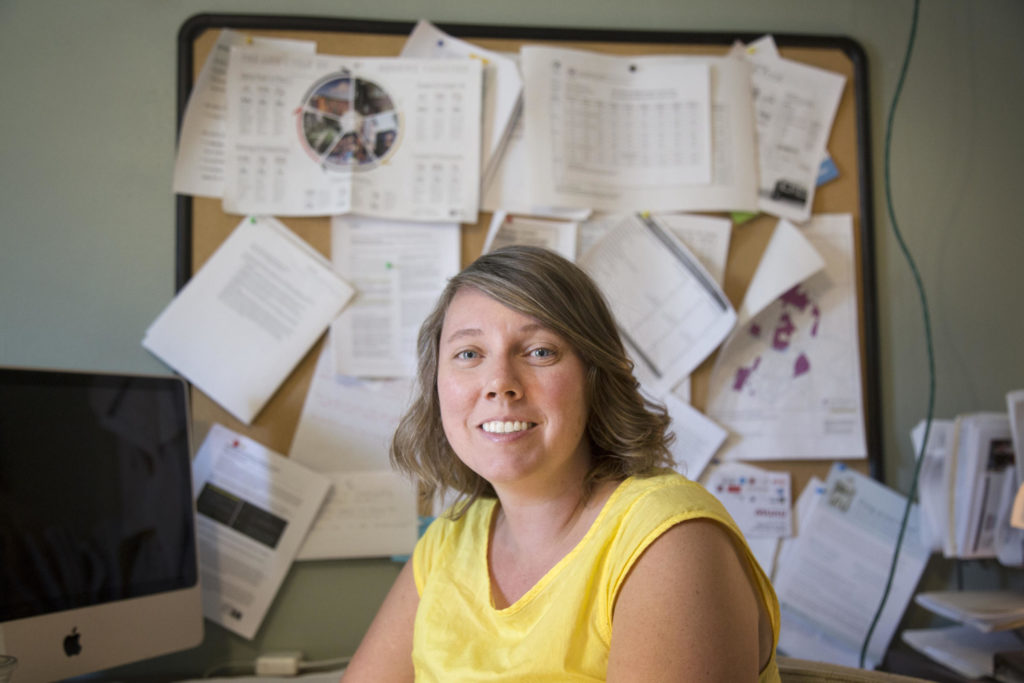Is ‘missing middle’ housing still missing from CodeNEXT?
Friday, May 26, 2017 by
Audrey McGlinchy, KUT Jake Wegmann, an assistant professor of housing and real estate at the University of Texas, stood on the sidewalk in Mueller, a large mixed-use development on the site of Austin’s old airport. He pointed across the street to a string of attached, two-story homes.
“These are town homes,” he said. “Here’s some missing middle housing.”
Research shows that “missing middle” housing, or housing with anywhere from two to 50 units, can be more affordable than single-family homes or large apartment complexes in the same neighborhood. To be clear: Affordable housing advocates agree market-rate missing middle housing will most likely never be affordable to deeply low-income people, or a family of four making roughly $25,000 a year.
But since the 1980s, the city of Austin has limited the ability to build this kind of housing. Wegmann put it this way: “Why is it that if someone wants to knock down a small single-family house and replace it with a large single-family house, we say, ‘Oh, yeah, sure.’ Automatic. No problem. Nothing’s going to stop you.”
With CodeNEXT, the city’s rewrite of its land development code, the city is hoping to incentivize more construction of medium-density homes.
One way to do that is to lessen some of the requirements of builders during the permitting process. Currently, if a builder wants to build more than two units, it initiates a multilevel process, including what’s called a site plan review.
“It’s much more extensive,” said Greg Dutton, a senior planner with the city of Austin. “You have to show a lot more on your plans about how you’re complying with drainage and parking and traffic.”
Single-family homes and duplexes are exempt from site plan reviews. Under proposed changes, buildings with three to nine units would be exempt, too.
And then there’s zoning. Much of the city’s central, inner neighborhoods are zoned in such a way that permits no more than two housing units per lot. CodeNEXT adds two types of zoning to the existing one, including transect zones, or form-based code, which is intended to create opportunities for more missing middle housing.
But some affordable housing advocates say where more density is allowed, additional design requirements make it difficult to actually build missing middle housing.

Nicole Joslin
“What I’ve been seeing lately is a little disappointing,” said Nicole Joslin, executive director of the Austin Community Design and Development Center, an organization that works with local communities to design and build homes for people making less than the median family income. (For a family of four that’s about $81,000.)
“I’ve just been seeing a lot of instances in the areas where we’re intending to increase missing middle affordable housing, we’re putting other restrictions in place that make it difficult to achieve that,” she said.
Scott Turner, a residential builder in Austin, found as much when he studied what could be built on the city’s new transect zone 3, or the lowest-density zone. (Typically compared to the current single-family zone 3.)
While the zoning allows someone to build up to a duplex with an accessory dwelling unit, or “granny flat,” on the site (so three units in total), Turner found that was difficult to achieve. Citing setback requirements and story limits, he wrote in an email that he thought builders would be incentivized only to build large single-family homes on these lots.
Then there’s the question of where new missing middle housing should be built. Imagine Austin, the city’s comprehensive plan, calls for medium-density housing to be built on corridors – such as Burnet Road – which is what we see in the CodeNEXT maps.
“CodeNEXT is really being developed to effectuate existing policy … to use those existing policies as a basis for mapping,” Dutton said. “So, areas of town where we really didn’t have any direction to put any additional housing or density.”
For Wegmann, standing among the missing middle in Mueller, that’s something.
“If all we can do is build a little missing middle flanking corridors, then that’s an improvement,” he said, although he added that he would like to see more opportunities throughout the city.
Next month, the city of Austin will release the proposed changes to its density bonus program. Through that, the city can require income-restricted units in exchange for allowing a developer to build a denser building. It’s a tool the city can use to create more affordable housing.
This story was produced as part of the Austin Monitor’s reporting partnership with KUT. Photo by Jorge Sanhueza-Lyon/KUT.
The Austin Monitor’s work is made possible by donations from the community. Though our reporting covers donors from time to time, we are careful to keep business and editorial efforts separate while maintaining transparency. A complete list of donors is available here, and our code of ethics is explained here.
You're a community leader
And we’re honored you look to us for serious, in-depth news. You know a strong community needs local and dedicated watchdog reporting. We’re here for you and that won’t change. Now will you take the powerful next step and support our nonprofit news organization?









